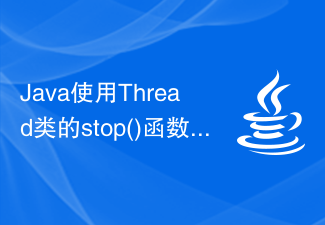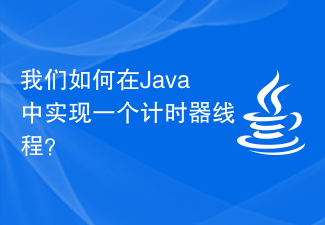1 Overview
1. What is a process?
A process is a relatively independent execution unit.
2. What is a thread?
Part of the process, the actual task executor in the process, must be attached to the process. The dependence of threads on processes is mainly reflected in:
Threads cannot be started without the process and must be started under the premise that the process is started.
#Threads must sometimes get data from the process.
# 3. What is the difference between threads and processes?
Threads and processes are two relative concepts. An object is called a process relative to the execution unit it owns. From the perspective of the superior executor to which it belongs, also is called a thread.
4. The design purpose, use and significance of multi-threading
CUP can only execute one thread at any point in time. Multi-threading The essence is that multiple tasks are executed alternately at high speed. If there is no data exchange between multiple threads, can be executed independently. Using multiple threads will not reduce the total execution time.
The main purpose of multi-thread design is not to increase the execution speed, but to execute each thread relatively evenly, so that a certain thread does not hold the CPU time slice for a long time, Other threads are waiting for a long time. Because the CPU time slice switches between multiple threads quickly, beyond the range that human senses can detect, it feels like multiple tasks are being executed.
For example, when multiple people visit the same website, it takes 5 minutes for each person. If multi-threading is not used, only one person is allowed to enter the website at the same time, and most other people You have to wait for 5 minutes, the user experience is very poor. This uses multi-threading. After one person enters, the CPU turns to other users, allowing other users to enter one after another. The user experience is improved, although the total execution time is not reduced.
5.CPU scheduling mode
Time-sharing scheduling mode: The system allocates CPU time slices to each thread evenly .
Preemptive scheduling mode: Each thread competes for CPU time slices, and CPU time slices are distributed unevenly among threads.
Second thread creation
1.Java SE API provides two ways to create threads:
Implement the Runnable interface and pass the object of the implementation class as a parameter to the constructor of Thread.
# Directly inherit the Thread class.
2. No matter which method is used, the tasks that need to be performed must be placed in the run method.
3. The difference between the two creation methods:
⑴Java adopts single inheritance, that is, a class can only inherit one parent class, while allowing If a class implements multiple interfaces and creates threads by inheriting Thread, this class loses its only inheritance opportunity.
⑵ Different ways to achieve resource sharing
First of all, it needs to be clear that resource sharing can also be achieved by inheriting Thread to create threads. Just because multiple threads created through the new keyword are different objects, shared resources can only come from the outside, usually injected through the constructor.
#And by creating threads by implementing the Runnable interface, you canuse the same implementation class object to create multiple threads, realizing resource sharing , shared resources come from inside the thread.
4. Creating threads by implementing the Runnable interface not only retains the only inheritance opportunity, but also makes resource sharing operations relatively simple, so it is generally Use this method to create threads.
5. Realize resource sharing by inheriting Thread:
External classes that provide shared resources
package com.test.thread.extendsThread;public class MyClass {public int count;
}
Thread thread subclass
package com.test.thread.extendsThread;public class MyThread extends Thread {private MyClass obj;public MyThread() {super();
}public MyThread(MyClass obj) {super();this.obj = obj;
}
@Overridepublic void run() {
System.out.println("obj=" + obj);while (true) {synchronized (obj) {if (obj.count > 0) {try {
Thread.sleep(1000);
} catch (InterruptedException e) {
e.printStackTrace();
}
System.out.println(Thread.currentThread().getName() + "----当前数量=" + obj.count--);
} elsereturn;
}
}
}
}Test class
package com.test.thread.extendsThread;import org.junit.Test;import com.test.thread.synchronizedTest.demo02.MyTestRunnable;import net.sourceforge.groboutils.junit.v1.MultiThreadedTestRunner;import net.sourceforge.groboutils.junit.v1.TestRunnable;public class ThreadExtendsTest {/** * JUnit单元测试不支持多线程测试,使用GroboUtils进行多线程测试(导入架包)
*
* @throws Throwable */@Testpublic void test01() throws Throwable {
MyClass obj = new MyClass();
obj.count = 10;
MyThread myth01 = new MyThread(obj);
MyThread myth02 = new MyThread(obj);
MyThread myth03 = new MyThread(obj);
MyTestRunnable t01 = new MyTestRunnable(myth01);
MyTestRunnable t02 = new MyTestRunnable(myth02);
MyTestRunnable t03 = new MyTestRunnable(myth03);
TestRunnable[] tr = new TestRunnable[3];
tr[0] = t01;
tr[1] = t02;
tr[2] = t03;
MultiThreadedTestRunner mttr = new MultiThreadedTestRunner(tr);
mttr.runTestRunnables();
}// 放在主线程中测试public static void main(String[] args) {
MyClass obj = new MyClass();
obj.count = 10;
MyThread t01 = new MyThread(obj);
MyThread t02 = new MyThread(obj);
MyThread t03 = new MyThread(obj);
t01.setName("t01");
t02.setName("t02");
t03.setName("t03");
t01.start();
t02.start();
t03.start();
}
}
三 线程生命周期
1.什么是线程的生命周期?
由不同阶段构成的线程从出生到死亡的整个过程,叫做线程的生命周期。
2.线程生命周期的意义
了解线程的生命周期能够更好地掌握线程的运行情况,比如线程的就绪状态,意味着不是调用start方法之后,线程立即执行。
3.生命周期的几个阶段:
出生状态:线程创建完成,尚未开启前的状态。
就绪状态:调用start方法开启线程,线程尚未运行的状态。
运行状态:线程获取CPU时间片执行时的状态。
休眠状态:线程调用sleep方法后进入指定时长的休眠状态,时间结束进入就绪状态。
等待状态:监听对象在线程内部调用wait方法后,线程失去对象锁,进入等待状态。
阻塞状态:线程发出输入或者输出请求后进入阻塞状态。
死亡状态:run方法执行完毕,线程死亡。
四 线程的加入
一个线程A在另一个线程B内部调用join方法,B线程中止,A线程开始执行,A线程执行完毕,B线程才开始执行。
五 线程优先级
线程优先级设定了线程获取CPU时间片的概率,仅仅是一种概率,不能保证优先级高的线程一定优先获得CPU时间片。
线程优先级分为10个等级,从1-10,数值越大,优先级越高,通过setProprity(int)方法设置。
六 线程礼让
Thread.yield,线程礼让只是通知当前线程可以将资源礼让给其他线程,并不能保证当前线程一定让出资源。
七 同步机制
1.什么是线程同步机制?
使得同一资源同一时刻只能有一个线程访问的安全机制,即一个线程访问完毕,其他线程才能访问。
2.同步机制的目的
由于目标资源同一时刻只有一个线程访问,解决了线程安全问题。
3.什么是线程安全问题?
⑴线程安全问题产生条件
多线程并发访问。
存在可修改的共享数据。
⑵第一个线程获取了共享数据,操作结束前,第二个线程修改了该数据,导致第一个线程运算时采用的不是获取时的数据。
4.同步机制解决线程安全问题的原理
synchronized(共享对象){ 修改共享数据的代码 }上述操作给修改共享数据的代码加了一把对象锁。任何一个对象只有一把对象锁,线程只有获得了对象锁才能访问加锁的资源。一个线程获取了对象锁,执行加锁的代码,执行完毕,归还对象锁,其他线程开始争夺对象锁,访问资源。
5.类锁
synchronized关键字加到静态方法上时,形成类锁,执行该方法上必须获取类锁。
类锁与对象锁是两种不同的锁,允许一个线程持有类锁,另一个线程持有对象锁。
6.synchronized关键字
synchronized关键字加在成员方法,该方法成为同步成员方法,由于一个对象只有一把对象锁,一个线程访问了一个同步成员方法,其他线程不能访问其他同步成员方法。
同步方法不可以被继承,同步方法在子类中失去同步机制。
7.判断条件的设置
在同步机制中,如果同步代码的执行需要满足一定条件,那么将判断条件放在锁内,保证当前获取了锁的线程在执行同步代码时满足执行条件。如果放在锁外,有可能出现当前线程获取了锁以后不满足执行条件的情况。
不存在线程安全问题的做法:
public void run() {
System.out.println("obj=" + obj);while (true) {synchronized (obj) {if (obj.count > 0) {try {
Thread.sleep(1000);
} catch (InterruptedException e) {
e.printStackTrace();
}
System.out.println(Thread.currentThread().getName() + "----当前数量=" + obj.count--);
} elsereturn;
}
}
}If the judgment condition obj.count>0 is placed in the while statement, it may happen that when a thread enters the while statement, the count is 1, meets the condition, enters, and waits to acquire the object lock. The thread currently holding the object lock completes execution, count becomes 0, and the waiting thread acquires the object lock. When count=0, executes the synchronization block and the judgment condition fails.
8 Deadlock
1. What is a deadlock?
Thread A needs multiple locks. Thread B holds the locks that A lacks and lacks the locks held by A. Because the thread will not release the held locks before acquiring all the locks. Lock, This brings thread A and thread B into a stalemate, and the entire process is in a stagnant state.
2. How to avoid deadlock?
Reduce the number of locks in the synchronization mechanism and try to avoid the same lock appearing in multiple places.
9 Daemon thread
1. User thread?
Generally, the threads created are user threads, that is, the thread is not explicitly set as a daemon thread and is not created within the daemon thread.
2. The main thread belongs to the user thread.
3. What is a daemon thread?
A thread that runs in the background and provides services to user threads.
4. Daemon thread creation
The user thread calls the setDaemon(true) method, or creates a thread inside the daemon thread.
5. The role of the daemon thread
The daemon thread is used to provide services to user threads, such as garbage collectors.
6. The JVM terminates after all user threads have completed execution, regardless of whether the daemon thread has completed execution at this time.
7. The daemon thread runs in the background and ends automatically after all user threads end.
Comparison of ten wait and sleep methods
1. Existence range
The wait method is Object-level, that is, any object in java has this method, like toString.
#The sleep method only exists in Thread and its subclasses.
2. Function
##sleep causes the current thread to sleep and releases the CPU time slice. Locks held will not be released.
wait is used for inter-thread communication, and the object manages all threads that use the object as a lock. Called by the lock object in the synchronization code, causing the current thread to release the object lock held by .
3. Usage method
The sleep method is a static method, directly through Thread Call, Thread.sleep.
# is used in synchronization code and is called by the lock object.
4. Related methods
- ##obj.notify(): Randomly wake up object monitoring A thread on the server enters the ready state. Once it obtains the object lock and CPU time slice, it continues execution from the waiting point.
It does not re-enter the run method or synchronization code.
- obj.notifyAll(): Wake up all waiting threads on the object listener and make them all enter the ready state.
十一 ThreadLocal
1.线程局部变量,为每一个线程提供一个变量的副本,使得各个线程相对独立地操作变量,避免线程安全问题。
2.首先必须明确一点,ThreadLocal.get()获取的变量副本必须手动传入:
ThreadLocal.set(Object obj)
初次获取时,判断线程局部变量中是否保存有变量副本,如果没有则手动传入,在该线程中下次获取的就是初次传入的对象。
3.ThreadLocal的目的是保证在一个线程内部,一次创建,多次获取。
4.基本原理:
将初次传入的变量与线程绑定,线程不变,变量不变。
十二 GroboUtils多线程测试
1.JUnit测试不支持多线程,GroboUtils提供了对多线程测试的支持,使用时需要导入架包。
2.几个比较重要的类:
TestRunnable:实现了Runnable接口,run方法中运行的是runTest方法,runTest方法是一个抽象方法。
MultiThreadedTestRunner:负责管理并开启多个线程。
3.测试步骤
⑴继承TestRunnable,实现其中的抽象方法runTest,将需要运行的代码放入该方法中。通常为子类定义一个有参构造方法,方法形参为需要测试的线程,在runTest方法中调用测试线程的run方法,从而将将需要执行的代码注入runTest方法中。
⑵创建测试线程数组,将需要测试的TestRunnable实现类传入其中:
TestRunnable[] tr=new TestRunnable[len];
⑶根据测试线程数组创建线程管理与运行对象并开启多线程:
MultiThreadedTestRunner mttr=new MultiThreadedTestRunner(tr); mttr.runTestRunnables();
The above is the detailed content of What are processes and threads?. For more information, please follow other related articles on the PHP Chinese website!
 8核16线程是什么意思?Feb 02, 2023 am 11:26 AM
8核16线程是什么意思?Feb 02, 2023 am 11:26 AM8核是指CPU有8颗物理核心,16线程是指CPU最多同时可以有16个线程处理任务。核心数和线程数是电脑CPU的重要性能指标,CPU的核心数越高处理速度就越高;线程数越多越有利于同时运行多个程序,因为线程数等同于在某个瞬间CPU能同时并行处理的任务数。多线程可最大限度地实现宽发射、乱序的超标量处理,提高处理器运算部件的利用率,缓和由于数据相关或Cache未命中带来的访问内存延时。
 Java错误:JavaFX线程卡顿错误,如何处理和避免Jun 24, 2023 pm 05:52 PM
Java错误:JavaFX线程卡顿错误,如何处理和避免Jun 24, 2023 pm 05:52 PM在进行JavaFX应用程序开发的过程中,我们常常会遇到JavaFX线程卡顿错误。这种错误的严重程度不同,可能会对程序的稳定性和性能产生不利的影响。为了保证程序的正常运行,我们需要了解JavaFX线程卡顿错误的原因和解决方法,以及如何预防这种错误的发生。一、JavaFX线程卡顿错误的原因JavaFX是一个多线程的UI应用程序框架,它允许程序在后台线程中执行长时
 什么是程序运行时指令流的最小单位Aug 23, 2022 pm 02:16 PM
什么是程序运行时指令流的最小单位Aug 23, 2022 pm 02:16 PM“线程”是程序运行时指令流的最小单位。进程是指一个具有一定独立功能的程序,而线程是进程的一部分,描述指令流执行状态;线程是进程中的指令执行流的最小单位,是CPU调度的基本单位。一个线程是一个任务(一个程序段)的一次执行过程;线程不占有内存空间,它包括在进程的内存空间中。在同一个进程内,多个线程共享进程的资源;一个进程至少有一个线程。
 Go语言中线程和进程的区别解析Apr 03, 2024 pm 01:39 PM
Go语言中线程和进程的区别解析Apr 03, 2024 pm 01:39 PMGo语言中的进程和线程:进程:独立运行的程序实例,拥有自己的资源和地址空间。线程:进程内的执行单元,共享进程资源和地址空间。特点:进程:开销大,隔离性好,独立调度。线程:开销小,共享资源,内部调度。实战案例:进程:隔离长时间运行的任务。线程:并发处理大量数据。
 go语言中协程与线程的区别是什么Feb 02, 2023 pm 06:10 PM
go语言中协程与线程的区别是什么Feb 02, 2023 pm 06:10 PM区别:1、一个线程可以多个协程,一个进程也可以单独拥有多个协程;2、线程是同步机制,而协程则是异步;3、协程能保留上一次调用时的状态,线程不行;4、线程是抢占式,协程是非抢占式的;5、线程是被分割的CPU资源,协程是组织好的代码流程,协程需要线程来承载运行。
 Java使用Thread类的stop()函数强制终止线程的执行Jul 26, 2023 am 09:28 AM
Java使用Thread类的stop()函数强制终止线程的执行Jul 26, 2023 am 09:28 AMJava使用Thread类的stop()函数强制终止线程的执行在Java多线程编程中,有时候我们需要强制终止一个正在执行的线程。Java提供了Thread类的stop()函数来实现线程的强制终止。本文将介绍stop()函数的用法,并提供代码示例来说明。在介绍stop()函数之前,我们先了解一下Thread类的几个常用方法:start():启动线程,使线程进入
 Microsoft计划在Windows上的Outlook经典应用程序中引入AI驱动的CopilotOct 19, 2023 pm 11:13 PM
Microsoft计划在Windows上的Outlook经典应用程序中引入AI驱动的CopilotOct 19, 2023 pm 11:13 PMMicrosoft显然不会将其强大的人工智能支持的Copilot工具保留为新应用程序的独家功能。现在,该公司刚刚宣布计划在Windows上的Outlook经典应用程序中引入Copilot。正如其365路线图网站上发布的那样,预览将于明年<>月开始,直到<>月在当前频道的桌面上在全球范围内推出。Copilot是一种生产力工具,它使用大型语言模型(LLM)来帮助用户完成编写电子邮件、汇总文档和翻译语言等任务。它的主要功能之一是它能够总结电子邮件
 我们如何在Java中实现一个计时器线程?Aug 30, 2023 pm 02:49 PM
我们如何在Java中实现一个计时器线程?Aug 30, 2023 pm 02:49 PMTimer类安排任务在给定时间运行一次或重复。它还可以作为守护线程在后台运行。要将Timer与守护线程关联起来,需要使用一个带有布尔值的构造函数。计时器以固定延迟和固定速率安排任务。在固定延迟下,如果任何一个执行被系统GC延迟,则其他执行也会延迟,并且每次执行都会延迟对应于之前的执行。在固定速率下,如果任何执行被系统GC延迟,则连续发生2-3次执行以覆盖与第一次执行开始时间相对应的固定速率。Timer类提供了cancel()方法来取消计时器。当调用该方法时,定时器终止。Timer类仅执行实现Ti


Hot AI Tools

Undresser.AI Undress
AI-powered app for creating realistic nude photos

AI Clothes Remover
Online AI tool for removing clothes from photos.

Undress AI Tool
Undress images for free

Clothoff.io
AI clothes remover

AI Hentai Generator
Generate AI Hentai for free.

Hot Article

Hot Tools

EditPlus Chinese cracked version
Small size, syntax highlighting, does not support code prompt function

Safe Exam Browser
Safe Exam Browser is a secure browser environment for taking online exams securely. This software turns any computer into a secure workstation. It controls access to any utility and prevents students from using unauthorized resources.

MantisBT
Mantis is an easy-to-deploy web-based defect tracking tool designed to aid in product defect tracking. It requires PHP, MySQL and a web server. Check out our demo and hosting services.

SublimeText3 English version
Recommended: Win version, supports code prompts!

SublimeText3 Mac version
God-level code editing software (SublimeText3)







